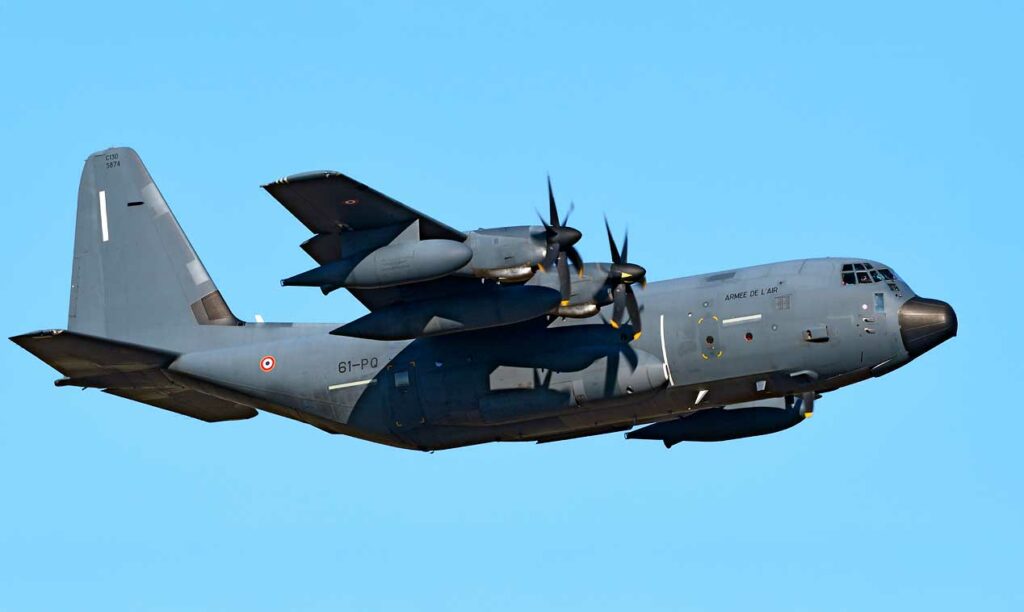
Lockheed Martin’s C-130J has reached 122,500 equivalent flight hours, extending its expected structural life by 40%.
Lockheed Martin’s C-130J Super Hercules tactical military transport aircraft has officially exceeded the structural life projections established during its design. According to the latest tests, its wing structure is now certified for a service life of 122,500 equivalent flight hours (EFH), a 40% increase over initial projections. This result confirms the robustness of the platform, which is used by 28 operators in 23 countries. With its improved performance and proven reliability, the C-130J is establishing itself as a sustainable solution for complex tactical missions, including troop transport, medical evacuation, weather reconnaissance and firefighting.
40% longer service life validated by flight tests
Lockheed Martin’s main announcement concerns the extension of the structural life of the C-130J Super Hercules to 122,500 equivalent flight hours (EFH). This is crucial in the aviation industry, as it determines how long an aircraft can fly safely without major structural overhaul.
The C-130J’s original service life was set at approximately 87,500 EFH, which is the expected average for a tactical transport aircraft in its class. However, recent tests conducted as part of the airframe validation program have demonstrated 40% greater structural endurance, extending the aircraft’s service life.
In concrete terms, a longer service life translates into direct savings for operators. It reduces the frequency of fleet replacement or withdrawal, thereby easing long-term maintenance budgets. In the United States, the cost of completely replacing a C-130J is between $70 million and $90 million, depending on specifications and equipment. Extending the structural life therefore allows multi-billion dollar investments to be postponed for several decades.
Operationally, this means that air forces can maintain a high level of fleet availability without major interruptions for renovation or replacement. This is a significant strategic advantage, particularly in a context of rapid deployment to theaters of operations where air logistics are essential.
A modernized aircraft to meet contemporary requirements
The C-130J Super Hercules is the latest evolution of the C-130 platform, which first entered service in the 1950s. The J-model was designed to replace the C-130E, which had become obsolete in the US Air Force and allied forces.
Major improvements include:
- Fully digital avionics (glass cockpit)
- Rolls-Royce AE 2100D3 turboprop engines
- Six-blade composite propeller
- Optimized fuel consumption
- A reduction in the crew required from five to three members.
Thanks to these developments, the C-130J has a maximum cruising speed of 660 km/h, a range of over 4,000 km, and a payload capacity of 19 tons. This makes it one of the few transport aircraft capable of operating in extreme conditions while offering simplified maintenance and operating costs reduced by nearly 25% compared to previous versions.
The extended C-130J-30 version, with its fuselage extended by 4.57 meters, can carry more equipment and personnel. For example, it can carry up to 92 seated passengers, or 128 seated on the floor, or 6 standard cargo pallets, depending on the configuration.

Strategic versatility in all theaters of operation
One of the C-130J’s key strengths is its ability to operate from short, unprepared or semi-permanent runways, making it indispensable in poorly equipped areas, during humanitarian crises or conflicts.
In the United States, the C-130J is operated by:
- Air Mobility Command (strategic transport),
- Air Force Special Operations Command (special operations),
- Air National Guard and Air Force Reserve Command (reserve and local missions).
The aircraft performs a wide range of missions:
- Troop and cargo transport,
- Medical evacuation with full medical configuration,
- Weather reconnaissance (particularly in the WC-130J version used by the “Hurricane Hunters”),
- Firefighting with systems such as the MAFFS (Modular Airborne Fire Fighting System), which can release up to 13,250 liters of retardant.
The flexibility of the C-130J makes it a rapid deployment and tactical logistics tool, particularly valued in joint operations where speed and agility are key.
An export success and a global standard in tactical transport
The C-130J is not only used by the United States. According to Lockheed Martin, the aircraft is in active service with 28 military operators in 23 countries, making it the global standard in tactical transport.
Customer countries include:
- The United Kingdom,
- Australia,
- Canada,
- Italy,
- France (operates the C-130J-30 and KC-130J),
- India,
- Norway,
- Israel,
- South Korea.
This success can be explained by the proven reliability of the platform, but also by its adaptability to the needs of each army. Some operators have integrated specialized versions, such as the KC-130J refueling aircraft and the EC-130J electronic warfare aircraft.
From a budgetary standpoint, the aircraft is competitive with competitors such as the Airbus A400M, which is more expensive (around $150 million) and less suited to rudimentary runways. In terms of operating costs, the C-130J remains one of the most economical aircraft in its class.
Its export is also supported by the US Foreign Military Sales (FMS) program, which facilitates acquisition for partner countries while ensuring NATO interoperability.
Enhanced operational longevity for decades to come
The extension of the C-130J’s structural life span paves the way for operational extension into the 2060s and beyond. This is crucial for military leaders planning their capacity projections over several decades.
With replacement schedules often frozen or delayed for budgetary reasons, having a reliable, proven aircraft with a structure that stands the test of time is a clear strategic and financial advantage. It allows for better maintenance cycle planning, reduces the need for new spare parts, and optimizes training costs.
Increased durability also boosts interest in retrofit or modernization programs (radars, self-protection systems, data links), which can be integrated into a structurally sound aircraft without the need for complete replacement.
Finally, extending service life contributes to the resilience of military fleets, particularly in an uncertain geopolitical context where supply chains and replacement programs can be disrupted.
War Wings Daily is an independant magazine.